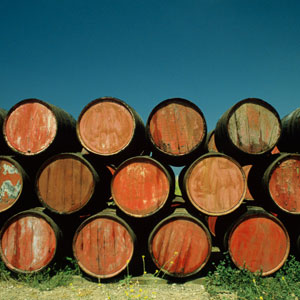Making Fortified wines
Fortified literally means ‘made stronger’, and refers to the alcohol which is increased by the addition of a distilled spirit, generally grape brandy. Different styles of fortified wine are made depending on at what point the brandy is added.
Jerepigo
This is made by adding brandy to unfermented grape juice, often Muscadel. By raising the alcohol level over a certain percentage, any natural yeasts in the grape juice are killed off so the wine remains sweet but stable.
Sherry
Sherry comes from Spain and legally-speaking, we cannot call the wine which we produce sherry. However, it is generally made in the same was as in Spain although different grapes tend to be used – SA uses Chenin Blanc and Spain uses Palomino and Pedro Ximenez grapes.
The grapes are fermented normally until all the sugar is used up and the wine is dry. At this point, some grape brandy is added – but not enough to kill yeast entirely as the special flavour of sherry is derived from a yeasty covering called flor. This develops in half-filled barrels on top of the wine and gives sherry its typical yeasty, oxidised flavours.
After the flor has developed sufficiently, the alcohol level is raised again and the wine passes through a solera. Nope, not an ice cream, but a system of stacked barrels. The top barrels are filled with the latest vintage and the bottom ones contain the oldest wines. Every year, some is drawn off from the bottom barrels for bottling and the resulting space is filled by wine from the next layer up through anything up to 14 different layers of barrel. This allows for a very consistent, complex product and means that sherry producers always have wine ready to sell.
Port
Port comes from Portugal and, as with sherry, moves have been taken to stop non-Portuguese wines being referred to as port. At the moment, ‘Cape Vintage’ seems to be the popular name in SA.
Port is generally made from thick-skinned grape varieties such as Tempranillo, Touriga Nacional, Tinta Barocca and Touriga Francesa because it is easier to extract the colour and tannin required from these grapes. Port is made by stopping the fermentation part-way through so that some sugar is left in the wine. The fermentation is stopped by adding grape brandy as yeast cells die if there is too much alcohol present.
The problem with this is that you need to make sure you get all the colour and tannin out before killing off the yeasts. Hence the traditional use of foot-stomping – a highly efficient, but costly method of working the grapes as hard as possible in a very short time. Nowadays, most port is made by machinery specially designed to extract maximum colour and tannin. After fortification, the port is aged in barrels before bottling and maturing.

